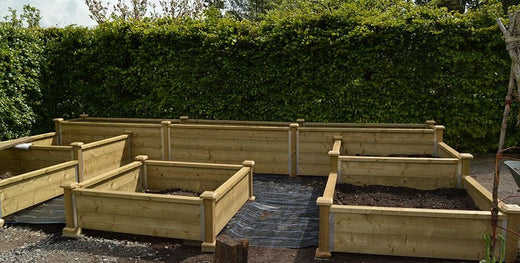Raised beds in the garden allow you to grow plants not suitable for your garden
Image above: Raised beds in construction at Sizergh Castle, Kendal
A raised bed is an area of soil enclosed in a low wall, higher than the surrounding soil level. Raised beds have certain advantages over just planting straight into the ground and for anyone who likes order and neatness they are a no-brainer. They are mainly used for growing fruit and vegetables but some gardeners also use them to grow cut flowers, they can also be incorporated into your design for an ornamental garden. Construct them to different heights to create interest in a contemporary garden. If you have mobility issues and find it difficult to bend right down to the ground, they are the perfect answer as you can construct them as high as you need. Top soil is quite expensive and if you do need to construct high beds but only want to grow shallow rooting crops or annuals fill the bottom with a cheaper material, such as hard core, just make sure it is not contaminated.

Raised beds enable you to have a longer growing season as they drain and heat up quicker in spring, especially if you cover them with horticultural fleece. On the down-side they get colder in winter so bear this in mind if you plan on growing perennial crops. They also dry out quicker in summer so need more watering and installing a watering system can be quite difficult. Another advantage of raised beds is that if you construct them narrow enough to be reached from both sides you won’t be walking on them, so soil compaction won’t be a problem.
You can grow almost anything in a raised bed by filling with soil to the plant’s exact requirements; if you garden on an alkaline soil you can grow acid loving plants by filling the bed with ericaceous compost. You can grow plants which thrive on well drained soils even though you garden on clay by adding copious amounts of grit and a loam-based soil. The depth of the beds can vary according to what you want to grow, salad crops and annuals only need a shallow soil whereas root crops will need something deeper. Just remember if you want to follow a crop rotation system for your vegetables having beds of differing soil depth will restrict what species you grow or make it extremely complicated. Raised beds are ideal for asparagus as you can give them exactly the conditions the love; they are impossible to grow if you garden on heavy clay as they need a really well drained soil. They may not be suitable for potatoes as these need to be harvested using a full-size garden fork so bear in mind you will need to be able to stand on the bed.

If you have a lot of beds to fill the best way is to buy topsoil by the ton, make sure you get the very best, the cheapest can often contain rubble and pernicious weeds. If you only have a few to fill, then try and get a deal on compost from your local nursery or garden centre. Once they have been built raised beds should just need an annual dressing of fertiliser, such as well-rotted farmyard manure, chicken pellets, general-purpose or blood, fish and bone, depending upon what you intend to grow the following season. If you have a problem clay or sandy soil then raised beds will make your life a whole lot easier. They also enable you to keep your paths clear and stop children and pets trampling the plants.
Raised beds can be constructed from a range of materials, the most common being timber, make sure it is not treated with anything harmful, but you can also use bricks, concrete blocks or woven willow. Whatever construction material you use there is no doubt that they are time consuming and fairly expensive so consideration must be given as to whether they are worth the expense and effort. If you are staying in your home long term then they are will worth it, but if you are only there for the short term consider whether they will add value to your home. If they are part of a whole garden transformation then that will more than likely enhance the value as an unkempt garden can be off-putting to buyers, after all who has the time to tackle an untamed jungle.

Chives growing in a wicker raised bed at Sizergh Castle
If you don’t want to go the time and expense of making raised beds then ‘no-dig’ beds are an acceptable alternative. Just create mounds of earth and organic matter; more information is available in the blog: ‘What are ‘no-dig’ beds?’.


